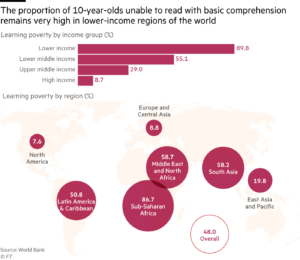How has COVID-19 impacted girls’ education? How can we mitigate that impact? In early October, UNESCO published a new study called When Schools Shut: Gendered impacts of COVID-19 school closures. It outlines the gender-specific effects of COVID and calls for the education community to attend to these effects in policies and program delivery.
Among other literature, the UNESCO report draws on findings from research funded by Echidna Giving to look at the impact of COVID-19 on girls. In case you missed our first two posts in September, we shared our findings on what we know about the effects of COVID-19 on girls’ return to school and how we can design gender-responsive remote learning. In October we published a third piece highlighting how to better support parents as allies for girls’ education. We found that parents are more supportive of girls’ education than we often give them credit for. If we offer low-tech solutions they can easily engage with, help remove economic barriers for them, and work with school leaders, CBOs, and others, we can maximize their support for better girls’ education outcomes.
Looking more broadly at what works for girls’ education at scale, David Evans, Amina Mendez Acosta and Fei Yuan find that making school cheaper, making schools more accessible, and teaching better are proven ways to expand girls’ access to education and to improve its quality at scale. It’s worth diving deeper into their work here, as well as important precursors to this work, which are outlined here.
For a useful synthesis of the current state of play in education in low and middle-income countries, check out the education special report that the Financial Times published in October. It focuses on how we can better invest in education and how COVID-19 has exacerbated the learning crisis across different geographies. The gist of the articles was that education was in crisis before the pandemic and we must take concerted action now or an entire generation will be lost.
 For instance, almost 90% of 10 year olds in the poorest countries cannot read with basic understanding, yet policy makers in 36 low- and middle-income countries prioritize vocational education and digital learning over foundational learning. This personal story from Mexico illustrates how even the most determined students have been dissuaded by the lack of learning opportunities offered remotely during the pandemic.
For instance, almost 90% of 10 year olds in the poorest countries cannot read with basic understanding, yet policy makers in 36 low- and middle-income countries prioritize vocational education and digital learning over foundational learning. This personal story from Mexico illustrates how even the most determined students have been dissuaded by the lack of learning opportunities offered remotely during the pandemic.
The articles shed light on how to turn things around by highlighting investment strategies to improve learning outcomes for the most vulnerable learners, including calling for children’s books to be affordable like generic medications. They also featured advice and strategies from learners themselves on how we can do a better job of reaching them and helping them to learn. For example, student activists in Thailand are organizing to remove authoritarian pedagogical culture from the Thai education system. These “Bad Students”are calling on schools to use learning strategies that teach students how to be more creative, innovative, and ask more questions.
Failing to take action now will have dire consequences. In op eds, Kevin Watkins (former head of Save the Children) argues that “Today’s setbacks are tomorrow’s inequalities in human development.” And President Uhuru Kenyatta of Kenya urgently reminds us that “Without adequate steps to mitigate this crisis, the pandemic will not only trigger irreversible intergenerational socio-economic regression in much of the world, it will also consign a generation of aspiring and talented girls to lives of poverty and hardship.”
For more interesting girls’ education efforts and insights from October, be sure to check out:
- The Coalition for Good Schools, which just launched. It is a coalition of and for the Global South that aims to synthesize knowledge, convene practitioners, and advocate to prevent violence against children in schools.
- New research on the Long run Effects of Secondary Schooling for Girls in Pakistan, which finds significant impacts of a conditional cash assistance program for girls attending secondary school in Pakistan and for their children.
- An analysis of teaching and learning materials for literacy instruction in Kano State, Nigeria: curricular relevance, cultural responsiveness and gender equity
- Reflections on how to make meaningful cultural adaptations of programs and assessments based on Evidence from Social Emotional Learning Assessments in Tanzania
- Open source resources for training school leaders on gender-inclusive approaches to school re-enrollment and continued education of girl students from Global School Leaders
